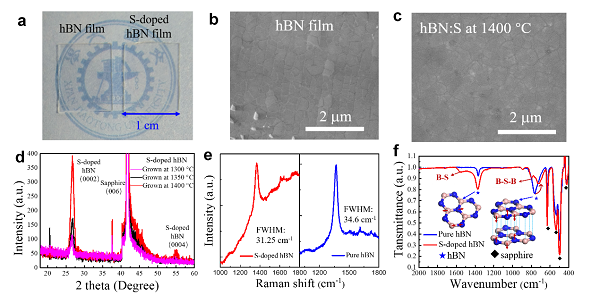XJTU achieves cutting-edge results in hexagonal boron nitride research

The research team's hBN homojunction deep-ultraviolet LED chip.
A research team led by Associate Professor Li Qiang from the School of Electronic Science and Engineering at Xi'an Jiaotong University (XJTU) has employed a low-pressure chemical vapor deposition (LPCVD) system to investigate the epitaxial growth and doping of large-area Hexagonal boron nitride (hBN) single-crystal films on sapphire substrates.
The team achieved high crystallinity by directly growing large-scale continuous hBN films on sapphire via ultra-high-temperature epitaxy (~1400 C). Subsequent substitutional sulfur (S) doping into hBN films realized n-type doping in large-area hBN single crystals, with a doping concentration of 1.21 percent.
Combining this with magnesium (Mg)-doped p-type hBN films, the team fabricated a homojunction PN structure (hBN:S/hBN:Mg). Photoluminescence (PL) analysis of the homojunction revealed that photo-generated carriers drift to the space charge region under the built-in electric field and undergo radiative recombination, enabling deep-UV emission (261–300 nm). This breakthrough in hBN doping demonstrates its viability as a primary material for deep-UV optoelectronic devices, opening new avenues for developing semiconductor-based deep-UV emitters at shorter wavelengths.
The study, Deep-UV Light Emission Based on the hBN:S/hBN:Mg Homojunction, was published in the authoritative international journal Advanced Science, with XJTU as the primary affiliation.
Hexagonal boron nitride (hBN) is a crucial ultra-wide bandgap semiconductor material with a graphene-like layered structure and unique optoelectronic properties. It holds significant potential in deep-ultraviolet (deep-UV) light-emitting devices and detectors.
Building on hBN's exceptional UV emission characteristics, recent studies have utilized exfoliated single-crystal hBN combined with graphene to develop deep-UV light-emitting devices (Nature Communications, 2021, 12(1): 7134; Advanced Materials, 2022, 34(21): 2201387).
However, achieving high-efficiency PN-junction semiconductor light-emitting devices remains a major goal in this field, with the n/p-type doping of hBN films, particularly n-type doping, posing a longstanding scientific and technical challenge.

